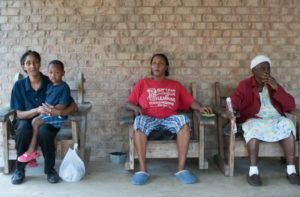
Absolute poverty exists when one cannot provide for any of their basic needs nor can they regularly access social services that can provide them with the resources they need. These are people who are in immediate danger of starvation or succumbing to the elements. Seldom have I knowingly engaged students in this situation. America is a blessed nation. In most of our cities there are food banks, clothing banks, short-term shelters and emergency healthcare centers that have the resources necessary to help those in immediate and desperate need, unless there has been a major disaster that caused a major disruption in services. However, it is not the fast death brought on by absolute poverty that concerns me. It is the slow physical, psychological and spiritual death of relative poverty that is of greatest concern
Relative poverty exists when there is economic and social inequality between people in a given society. This type of poverty is a social construct. Those who are relatively poor in their society usually have access to food and shelter, but it is usually just enough to placate them. Their standard of living is of low quality and quantity when compared to others in society who have access to better food and shelter and other amenities that not only allow them to survive but to thrive.
Those who are relatively poor usually exist on a combination of earned income and either charitable or government social services. Approximately 14.5 percent of the population, or 45 million people, live in relative poverty in the United States. Of that 45 million, 16 million are children. Presently, the federal government defines relative poverty for an individual as having a yearly income of $11,770. The federal government defines relative poverty for a family of four as having a yearly income of $24,450 or lower. However, research shows that a family of four must have an income nearly twice that in order to purchase their basic needs.
In most cities in America poverty is centralized. The poor are usually relegated to specific parts of a city. Either government subsidized housing is built in a manner where all of those living at the same income level live in the same place, or the realities of our market system only allow those who are relatively poor to live in very low-cost and low-quality housing in a specific part of the city. This centralization or clustering of the poor has some rather far-reaching negative effects that are social, environmental and personal in nature.
First, consider the effect of grouping those who are struggling through the same problem in a specific area. All involved are in a situation in which they must use their wits to acquire the most basic resources to survive. They all are working hard to get the least-paying jobs and to make up for what their income cannot provide with the application for government social services. People in this condition no longer strive for those things that are beyond their basic needs, and this can become the norm for this segment of a society. Like a social epidemic, poverty saps a person’s and then a group’s dreams and aspirations because all that is seen are those just behaving in ways that allow them to survive and the epidemic spreads. This phenomenon is called collective socialization.
Collective socialization exists when people within a closed society begin to conform to social norms, no matter how negative or self-destructive, because there is a limited number of role models providing a large amount of social pressure to act a certain way. George Galster states that this phenomenon can go unnoticed until a critical mass of seemingly insignificant social pressures is achieved, resulting in a noticeable, and at times overwhelming, consequence for those living in the area and beyond.
In America, we employ the Free Market System to resolve the problem of scarcity. Our system has five major elements: private ownership, freedom of choice, freedom of exchange, freedom to compete and economic incentive (the right to get as wealthy as you can). Any one of our country’s citizens, if they have the means, can purchase property. That person can choose to sell that property or what it yields. That person can exchange that property or what it yields for whatever commodity they wish. They are allowed to compete with others who have similar properties or yields. Finally, they can sell it or what it yields for whatever they can get for it and in case of the yield, how often they choose. This provides an incredible opportunity for the most ambitious in our nation.
However, there is a rationing device that determines who gets what property. That rationing device, in a free-market system, is called price. Price is contained in money. If one does not have the money, one cannot gain access. In America, one’s ability to earn the money is proportional to the marketability of one’s skills. I submit that many of those who are trapped in poverty are in this state primarily because they do not have skills that are marketable enough for them to earn enough money to raise them out of poverty. This malady befalls our people in a disproportionate manner.
Our people are members of a demographic that was freed from slavery 151 years ago, but has suffered racial discrimination and segregation for most, if not all, of the 20th century. We suffered at a level that far exceeded what new white immigrants suffered. This discrimination and segregation was manifested through legal codes, restrictive covenants and social norms that were openly accepted and proliferated. This plight marginalized us and forced us to live in specific areas within inner cities. It controlled where we lived; it also limited our access to education and what we could do in the labor market. The limitations placed on education and labor force participation led to lack of skills and disproportionate poverty.
It is important to note that shifts in economy exacerbated the condition of Blacks in America’s inner cities. Because of the lack of skill resulting from social, educational and labor market discrimination, Blacks suffered more adversely from economic shifts in industry. When market conditions affected the steel, rubber and automobile industries during the shift from the industrial age to the information age, we were left out in the cold world of unemployment and underemployment, lacking the skills to compete in the new labor market.
The purported savior of many in this situation was the creation and development of the welfare system. Those who found themselves “relatively poor” could now gain financial assistance from the government. However, there is a danger inherent in the “help” provided to the relatively poor. The tools that allow one to rise out of poverty — like education and opportunity — can dangle just out of reach of the person who is relatively poor. That same person can have their basic needs met, such as food, shelter, and clothing — providing them enough to survive in their present state but not enough to take advantage of the rewards of a free-market system.
Those who became accustomed to this existence directly and indirectly teach it to their children. However, this existence does not save, it enslaves. In the long run it does not build, it destroys. It does not bring equality, it brings disparity.
Welfare programs were designed to help those who suffered from absolute poverty because of social conditions imposed on them by oppressive discriminatory policies and norms. They targeted the most vulnerable of our society, but for the most vulnerable to reap the benefits of the system they had to remain in their plight, one of these being a broken family. Imagine the single mother with children on welfare who suddenly decides to wed a man who is in relative poverty but has a low-wage job. The financial consequences of that marriage can be devastating because of the marriage penalties that were embedded in welfare programs. A slight change in the couple’s income would cause a tremendous loss in welfare benefits.
Think about the number of people who then game the system so that they can have some semblance of family without losing the economic “blessings” of the welfare state. Think about the choice a woman faced, knowing that she would receive a greater welfare benefit if she remained single, under the law, rather than married. The consequences of gaming the system to have the best of both worlds are far-reaching for the individual and for an entire people.
In the 1960s, the out-of-wedlock birth rate for Blacks was 24.5 percent. Just 10 years later, it had risen to 50.3 percent for Blacks. As of 2015, the out-of-wedlock birth rate for Blacks was 73 percent. The birth rate for unmarried Black women far surpasses that of married Black women. Even when enslaved people were not allowed to marry, most of their children lived with their biological father and mother. During the end of slavery, continuing to the 1940s, 75 percent to 85 percent of Black children lived in two-parent families. However, today, in what is supposed to be the most progressive age, the Black family has been adversely affected, and I believe this phenomenon has greatly contributed to its demise. The family structure is not the only victim of dependence on the welfare state.
Research has shown that the breakdown of the family contributes to the proliferation of poverty. Results from the U.S. Census of 2010 show that the poverty rate for single parents in the Black community was 35.3 percent, but for married couples it was 6.9 percent in the same demographic. This reveals the cycle of poverty created by the breakdown of the family.
This system, though it alleviates absolute poverty, perpetuates relative poverty and therefore the cycle of poverty. I remember teaching a class in a public high school. One of my students was an 11th-grade student. At 17 she had four children. In that class there was another 17-year-old who was pregnant for the first time. The newly expecting mother wondered out loud how she would afford diapers and formula for her child. I remember being shocked at the advice the veteran mother gave her. To my amazement she schooled her regarding all of the money she could get from the government without really asking.
This young lady was a veteran at 17. She already knew how to game the system. She had discovered all the tricks of the trade to ensure her and her children’s basic needs were met. Do I believe that she was having children to get more money? No, I do not. However, when society removes the economic disincentives for having a child out-of-wedlock, it also removes the incentives for avoiding the situation. Premarital and unprotected sex no longer carries consequences or stigmas for our children. We have allowed society to create an amoral safety net that our children are using to their advantage. Though they are saved from absolute poverty in the short term, they are damned to the consequences of relative poverty in the long term.
I often think about the children of that 17-year-old mother of four. I think about the most likely future of her children. They are statistically far more likely to live in poverty because of the fatherless home in which they will be raised. They are statistically more likely to engage in criminal or anti-social activities than those children raised in a two-parent household. These are our children. They only constitute 13 percent of our country’s population but they account for 31.8 percent of arrests for forcible rape, 33.5 percent of arrests for aggravated assault, 55 percent of arrests for robbery and nearly 49 percent of all arrests for homicide. The U.S. Census of 2010 reports that 27.4 percent of Blacks live in poverty — that is 12 million of us. It is not absolute poverty, it is relative poverty. It is not by disaster, it is by design.
Mason West III has been an innovative leader in community-based program development for 15 years. He has developed and managed programs for companies, schools and governments at every level in the United States, England and Bermuda. He specializes in prevention, intervention and restoration strategies that restore lives and communities impacted by cyclical poverty, drugs, gangs and violent extremism. Mr. West earned his Bachelor of Arts degree in Theology at Oakwood College. He later earned his Masters degree in Urban and Regional Planning and Community Development from Alabama Agricultural and Mechanical University. Currently, he is pursuing his Doctoral Degree in Educational Leadership at the University of Tennessee.


